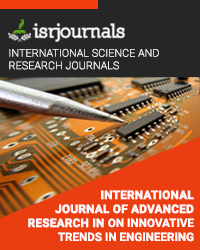a two stage dc-dc converter for a solar photovoltaic power conditioning unit
G. Ezhilarasan,M. Vijayalakshmi,T. Saravanan
Published in International Journal of Advanced Research in Electrical and Electronics Engineering
ISSN: 2321-4775 Impact Factor:1.6 Volume:1 Issue:2 Year: 08 November,2013 Pages:37-43

Abstract
In this work, the design and development of a DC -DC Converter using a two stage buck–boost operation is discussed. This converter is suitable for low power application such as a matrix LED lighting system. The advantage of this converter is that instead of using two controlled switches as in case of a conventional converter, this circuit uses one MOSFET as a switch. The circuit uses two inductors and two capacitors as energy transferring elements that are able to provide a good quality, high efficiency power supply to the load. In this paper the design of TSBB converter is analyzed with closed loop control using a PI controller circuit . Even with smaller values of inductor and capacitor a highly efficient power supply can be made. The main feature of this circuit compared to the other circuits proposed is, comparing with the circuits designed previously with the same concept is that, in this work a galvanic isolation between the load and the source is provided. Thus by a suitable controller and galvanic isolation the ripple magnitude in the output is reduced considerably. A simulation model of the TSBB converter with results is presented
Kewords
Two Stage buck–boost (TSBB) , LED Matrix, Duty cycle (𝛼), galvanic isolation, , discontinuous conduction mode (DCM), continuous conduction mode
Reference
[1] J. Marcos Alonso, Juan Viña, David Gacio Vaquero, “Analysis And Design of The Integrated Double Buck-Boost Converter As A High Power Factor Driver For Power LED Lamps’, IEEE trans on industrial electronics Vol.10 , No 10, pp 1949-2023,2011. [2] E. F. Schubert, “Light-Emitting Diodes”, 2nd ed. Cambridge, U.K.: Cambridge Univ. Press, 2006. [3] Cree X Lamp XP-C LEDs, 2010,” Data Sheet No. CLD-DS19”, Rev 4. [4] Y. Fang, S.-H. Wong, and L. Hok-Sun Ling, “A Power Converter With Pulse-Level-Modulation Control For Driving High Brightness LEDs,” 24th Annu. IEEE APEC , Feb. 15–19, 2009, pp. 577–581. [5] R. Nuttall, R. Shuttleworth, and G. Routledge, “Design of a LED street lighting system,” in Proc. 4th IET Conf. PEMD, Apr. 2–4, 2008, pp. 436–440. [6] H. Yuequan and M. M. Jovanovic, “A novel LED driver with adaptive drive voltage,” in Proc. 23rd Annu. IEEE APEC, Feb. 24–28, 2008, pp. 565–571. [7] Y.-K. Lo, K.-H. Wu, K.-J. Pai, and H.-J. Chiu, “Design and implementa- tion of RGB LED drivers for LCD backlight modules,” IEEE Trans. Ind. Electron., Vol. 56, No. 12, pp. 4862–4871, Dec. 2009. [8] Hadis Morkoç, “Handbook of Nitride Semiconductors and Devices”. Vol. 3. WILEY-VCH Verlag GmbH & Co. KGaA, Weinheim ISBN: 978-3- 527-40839-9 [9] J.Nancy Amala Dr.S.Edward Rajan R.Pon Vengatesh , “Design and Analysis of High Frequency Soft-Switching Boost Converter Employing Electronic PI-Controlle”r PROCEEDINGS OF ICETECT, pp 1-132, November 2011

